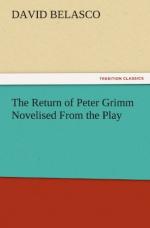She was in San Francisco at the time—I, in New York. After she passed out of the room, I roused my family and told what I had heard and seen. I said: “My mother is dead. I know she is dead;” but I could not convince my family that I had not been dreaming. I was very restless—could not sleep again. The next day (we were rehearsing “Zaza”) I went out for luncheon during the recess with a member of my company. He was a very absent-minded man, and at the table he took a telegram from his pocket which he said he had forgotten to give me: it announced the death of my mother at the time I had seen her in my room. I am aware that this could be explained as thought transference, accompanied by a dream in which my mother appeared so life-like as to make me believe the dream real. This explanation, however, does not satisfy me. I am sure that I did see her. Other experiences of a kindred nature served to strengthen my belief in the naturalness of what we call the supernatural. I decided to write a play dealing with the return of the dead: so it followed that when I was in need of a new play for David Warfield, I chose this subject. Slight of figure, unworldly, simple in all his ways, Warfield was the very man to bring a message back from the other world. Warfield has always appeared to me as a character out of one of Grimm’s Fairy Tales. He was, to my mind, the one man to impersonate a spirit and make it seem real. So my desire to write a play of the dead, and my belief in Warfield’s artistry culminated in “The Return of Peter Grimm.” The subject was very difficult, and the greatest problem confronting me was to preserve the illusion of a spirit while actually using a living person. The apparition of the ghost in “Hamlet” and in “Macbeth,” the spirits who return to haunt Richard III, and other ghosts of the theatre convinced me that green lights and dark stages with spot-lights would not give the illusion necessary to this play. All other spirits have been visible to someone on the stage, but_ Peter was visible to none, save the dog (who wagged his tail as his master returned from the next world) and to Frederik_, the nephew, who was to see him but for a second._ Peter was to be in the same room with the members of the household, and to come into close contact with them. They were to feel his influence without seeing him. He was to move among them, even appear to touch them, but they were to look past him or above him—never into his face. He must, of course, be visible to the audience. My problem, then, was to reveal a dead man worrying about his earthly home, trying to enlist the aid of anybody—everybody—to take his message. Certainly no writer ever chose a more difficult task; I must say that I was often very much discouraged, but something held me to the work in spite of myself. The choice of an occupation for my leading character was very limited. I gave Peter various trades and professions, none of which seemed to suit the part, until I made him a quaint old Dutchman, a nursery-man who loved his garden and perennials—the flowers that pass away and return season after season. This gave a clue to his character; gave him the right to found his belief in immortality on the lessons learned in his garden.




